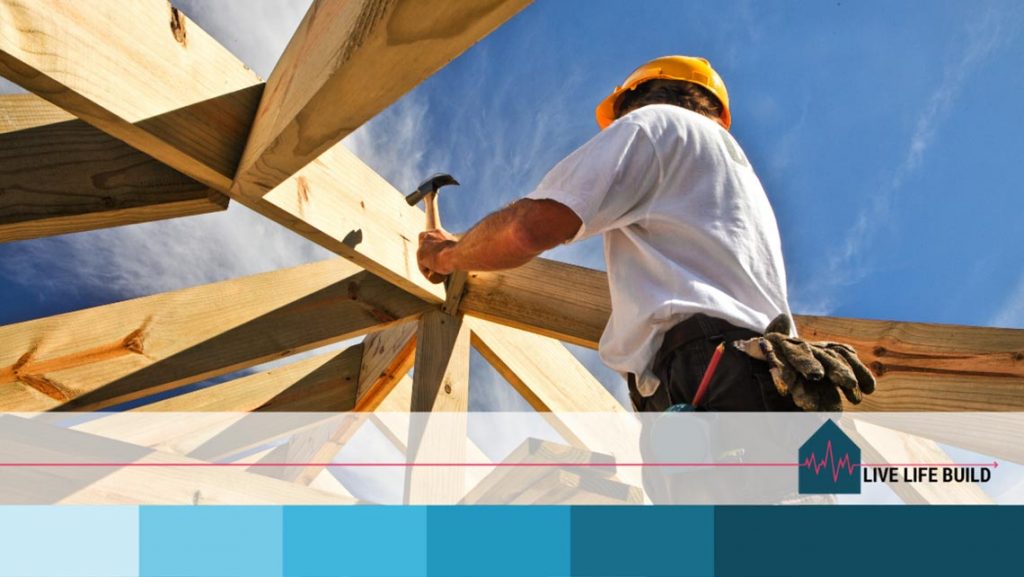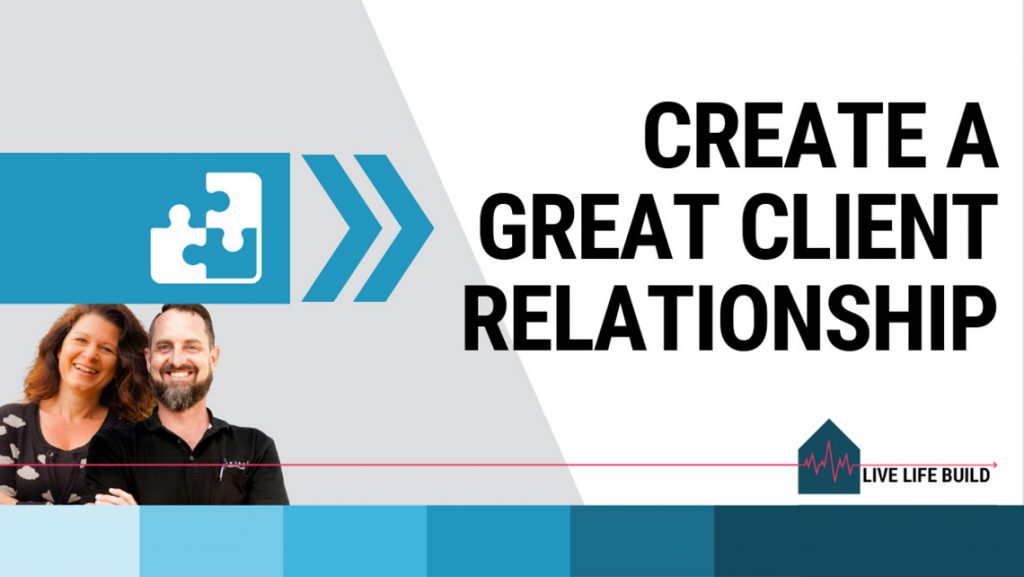How can you create a great client relationship where you feel respected as the builder and they feel taken care of as the client?
Set boundaries.
In this blog, we take you through the 5, 4, 3, 2, 1 of setting boundaries, and how important this is as a professional builder who wants to create a great client relationship.
Do you set boundaries for how clients work with you in their projects?
Do you follow through on these boundaries that you’ve set?
As a builder, it’s important to recognise that, if you expect others to respect your time, the value you add and how you prefer to work, that you need to set boundaries about this.
This will help you manage your clients’ expectations.
And it will help you be far more productive, stay focussed when you need to, and not be letting your business bleed into your family life and after hours time.
And believe it or not, this is actually the way to create a great client relationship.
Read on, as Amelia shares her thoughts on how your clients are actually wanting you to manage their expectations and set boundaries with them.
That’s right – saying ‘no’ may actually help your client relationship, and your building business.
Check out our 5, 4, 3, 2, 1 of our 6P Methodology PARTNERSHIPS: Create a great client relationship through setting boundaries.
5. SET BOUNDARIES: PROTECT YOUR TIME
Many builders complain that clients are contacting them at all hours of the day, during their family time, and on weekends as well.
However, these are the same clients who are very used to not being able to contact their accountant, or lawyer, or even hairdresser, outside of business hours.
For any business owner, time is an important commodity in your business. It’s the only finite thing as well. We all have 24 hours a day, and yet, you can see around you how differently everyone uses those same 24 hours.
For example, you could be finding it hard to get all your jobs done because you’re being interrupted by calls and emails from clients wanting to talk about their project. If you’re running your business with no admin staff, or a really small team, then chances are you’re having to deal with a lot of calls to keep your business running. If you’re not able to manage your time and availability for these calls, you’ll be finding it difficult to manage your business overall.
We know many builders who allow their work to bleed into family time, on the evenings and on the weekends. And whilst any business owner knows that the juggle can be challenging at times (especially when you’re busy), if this is happening all the time, that can put a huge strain on the personal relationships in your life.
Those people – your family – are usually the whole reason you’re doing business in the first place. However, if business is eating up all your family time, then it can cause a lot of stress, arguments and resentment.
This is why it’s important to protect your time.
The best way to do this is to behave like a professional business does. This means creating business hours. And then:
- advise clients and other contacts when you are available on the phone or on email;
- set the opening and closing times for your business and communicate them;
- include these in your contract documents so clients are aware of this before construction commences.
Setting boundaries around your time, and hours of operation, is an important step in managing expectations. It helps clients know when they can reach you, understand that you’re not ‘on tap’ for their project, and to respect your time overall.
Many builders we work with have set hours from Monday to Friday, that don’t include evenings or weekends. Their clients are able to organise their own schedules to work with this, because that is the expectation that’s been set from the outset. You don’t have to be available in your family time to work with homeowners on family homes.

4. SET BOUNDARIES: METHODS OF COMMUNICATION
Communication is one of the biggest frustrations for many clients who complain about a bad experience with their builder.
Often, we see project communication is handled far too casually. And given that much of it is happening inside the execution of a building contract, this can be problematic when issues arise.
To run your business and projects well, determine what method of communication you would prefer to use with clients. Remember that it’s useful to be creating and keeping a paper trail of all communication, so review potential methods for how they will assist with your record keeping.
There are various project management software products available that can be used for communication. And of course, there’s also simple email as well.
We hear some builders using WhatsApp and text messages to communicate with clients, which can be really dangerous if there are problems or disputes, due to the lack of formality in these methods. Plus, it means you can be fielding small messages all the time on your phone, which can be difficult to coordinate and take action on in a project when needed.
Instead, pick a method that will protect you, help the client feel more taken care of, enable clear communication, and assist with record keeping. And then stick to it.
Advise this to the client as part of your contract process, and then manage them and their expectations about this.
If they try to communicate with you via other avenues, remind them of what you’ve stipulated. This can be difficult to do when you’re used to saying ‘yes’ all the time to clients. However, behaving professionally as a builder, and being respected as a professional, means also setting boundaries about how you do business.
Set up your project filing so you can keep a record of this communication on a project-by-project basis as well.

3. SET BOUNDARIES: WHO IS INVOLVED?
Market research shows that over 80% of the purchasing decisions in any industry (including renovating and building) are made by, or heavily influenced by, women. And so, if you’re a residential builder who is renovating and building family homes, you may be working for a couple, but often find you’re mainly dealing with the female member of that couple.
However, if there are two people involved in the financial decision-making process around your work, then it’s essential that you work with both of them in all the significant steps.
You’re probably familiar with this already. You get an enquiry call to visit a house or building site to discuss a project. You’re met by one member of the couple because the other has been called away somewhere. You spend an hour or so discussing their project, what’s possible and how you work. It all seems great, and you get excited that it may be a good lead.
And then, when you follow up, you’re asked to ‘just come out again because my husband / wife (whoever was missing) would love to meet you too and has some questions they want to discuss’.
Or, you’re presenting your final proposal to a client, where you’ll be going through it in great detail. It’s a long meeting so you can cover all the questions, discuss the scope and ensure they’re across all that’s included and not included. However, one of them needs to be somewhere else and misses the meeting.
A week later, you get a call with requests for extra pricing, and a range of additional information. A job you thought was almost across the line now requires more running around, and more time and effort to convert.
Early in a project, this can be frustrating and time consuming. Later in the project, when you’re moving through costing, or even already inside a building contract, this can be dangerous for the project and your business.
Set boundaries with clients from the point of enquiry that you expect all decision-makers to be involved in key decisions – including the initial meeting. Right from the start, inform clients that all decision-makers need to be present when meeting with you. Manage their expectations as to how you’re prepared to work and what you require.
This can immediately show clients how you value your time, and what you expect from them in valuing it as well.
You can’t be surprised that clients take you for advantage, stuff you around, or chop and change things on you, when you don’t set boundaries on how you expect your time to be treated or valued.

2. SET BOUNDARIES: SITE
Setting boundaries – visiting site – regular site meetings, schedule for those, when can owner attend site, who they can talk to, importance of communication going through specific channels, structure for your site meetings (avoiding them turning up unannounced, or going on weekend, and then emailing / phoning with a bunch of issues). WHS issues too.
One of the biggest areas of confusion for homeowners is that they don’t understand that, during construction, the builder has full responsibility for their site and their project.
For the homeowner, the project is their dream they’re really excited about seeing be made a reality.
And so, they love the idea of being able to visit the site whenever they want, bring their friends and family, and wander around on a regular basis, seeing the home progress.
When you, as the builder, haven’t managed client expectations about site access and visits, this is what often plays out.
The homeowner turns up to the site unannounced.
You may not be there, or may be in the middle of something time-sensitive, which makes it difficult to give your client proper attention. They feel frustrated that you, as their builder, aren’t acknowledging them (your client, and the one paying for everything) with more significance. They wander around the site unattended, speak directly to your trades, and potentially give them instructions. Next thing you know, things have gone off track on site, your client is potentially frustrated with you, and a good relationship is now not-so-good.
Or, because you haven’t established business hours, or worse, given your client a key to the site fence, they come on the weekends or after hours.
They bring their kids. They wander around, checking things out, and then come home to send off an email with a bunch of questions or concerns about things they’ve seen on site. These things may be issues, unfinished work that they don’t understand, or simply a misinterpretation. However, you’re now having to manage their worries about those things. And meanwhile, you’ve exposed yourself to a huge amount of risk by allowing them to be on site in an unsafe way.
It’s important to set boundaries really early on about what you expect from your client when it comes to access to the building site. And it’s also important to establish a structure for communication about the project itself, which can be done through regular site meetings.
Remember that clients don’t always understand how onerous workplace health and safety legislation can be, or that the site is legally your responsibility during the build.
Ensure that, for each project you do, you establish a set time and day for regular site meetings. These give you the opportunity to show the client around, deal with any urgent issues, discuss work on site, answer their questions, help them feel confident about progress, and communicate any concerns with you.
Set a structure and agenda for these site meetings. And, as with any meeting you have with the client, minute the meeting so you have a written record of discussions, outcomes and actions to be taken. It will be helpful if any issues arise or there are differences of opinion about what was agreed to.
It’s also important to explain to clients who their main point of communication is, so that they know not to discuss project concerns or questions with your trades, subcontractors or other team members. This will avoid confusion, work being done unnecessarily or problems happening on site due to miscommunication.
Setting boundaries around behaviour on site, site meetings and site communication, will actually help your client feel far more comfortable overall. Clients actually enjoy it when builders manage their expectations, and give them clear directives about what is required.
It’s when clients feel they don’t know what to expect, or that they have to be on site every day to ‘keep an eye on things’ that problems occur.
Show the client that you have things in hand, that there’s a professional process for managing access to the site and all associated communication.

1. SET BOUNDARIES: DELIVER
What’s the most important part of setting boundaries? Actually sticking to what you’ve set as your boundaries!!
We see lots of builders have specific requirements about their business hours, or methods of communication, or site access and client meetings. And then the project will commence, things will start getting more informal, and the next thing you know, the builder is texting a client at 8pm at night, in response to their query about something they saw when driving past the site that day.
There’s a famous saying that “you teach people how to treat you” (Tony Gaskins). What this means is that, when you don’t stick to the boundaries you’ve set, you immediately say it’s ok for others to not stick to them too.
We find builders can be great at setting out with the best intentions on having specific business hours, or only communicating via email, or setting rules about site access.
However, because you’re people pleasers by nature, and want to create friendly working relationships with your clients, you let things slip when they don’t follow the rules and boundaries you’ve set.
What’s really interesting to understand, from someone who works with your clients day in, day out, is that they WANT you to deliver on your rules and boundaries.
I remember speaking with a homeowner about their project. She actually said to me that one of the best things the builder did was “manage their expectations”.
It made them feel like they were dealing with a professional, who’d done this many, many times before. And who had a process for managing their projects, getting things done properly and thoroughly.
They knew what to expect, what was expected of them, and it gave them certainty and confidence.
So, don’t be afraid to set boundaries for your business, and for your clients. It’s actually the best way to get started on creating a great client relationship, and helping the project experience be enjoyable for all involved.

So, here’s our 5, 4, 3, 2, 1 to identify your ideal project.
5. Have you asked your team what their goals are?
4. How can you help and facilitate your team’s goals?
3. What are your goals as a team?
2. Holding people accountable.
1. Celebrate the wins and create a good work environment.
Live Life Build’s 6P Methodology unlocks the 6 ways to elevate your building business:
PERSONAL | PROJECTS | PEOPLE | PARTNERSHIPS | PROCESSES | PROFESSIONAL
Is setting boundaries something you struggle with as a builder?

